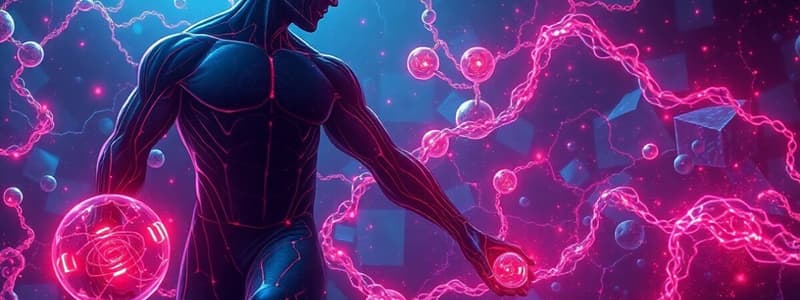Podcast
Questions and Answers
How do catabolic reactions differ from anabolic reactions?
How do catabolic reactions differ from anabolic reactions?
- Catabolic reactions occur only in the cytoplasm, while anabolic reactions occur only in the mitochondria.
- Catabolic reactions produce water, while anabolic reactions consume water. (correct)
- Catabolic reactions build larger molecules from smaller ones, while anabolic reactions break down larger molecules.
- Catabolic reactions release energy by breaking down larger molecules, while anabolic reactions require energy to build larger molecules.
If a cell's catabolic processes are more active than its anabolic processes, what is the likely outcome?
If a cell's catabolic processes are more active than its anabolic processes, what is the likely outcome?
- The cell will decrease in size and mass.
- The cell will grow and repair tissues more efficiently. (correct)
- The cell will store more energy in the form of large molecules.
- The cell will maintain a stable internal environment.
In dehydration synthesis, what molecule is produced as smaller molecules are bound together to form larger ones?
In dehydration synthesis, what molecule is produced as smaller molecules are bound together to form larger ones?
- Water ($H_2O$)
- Oxygen ($O_2$) (correct)
- Carbon dioxide ($CO_2$)
- Ammonia ($NH_3$)
How does hydrolysis contribute to catabolism?
How does hydrolysis contribute to catabolism?
Which of the following best describes the role of enzymes in metabolic reactions?
Which of the following best describes the role of enzymes in metabolic reactions?
What determines an enzyme's specificity for a particular substrate?
What determines an enzyme's specificity for a particular substrate?
What is the role of a rate-limiting enzyme in a metabolic pathway?
What is the role of a rate-limiting enzyme in a metabolic pathway?
How does negative feedback regulate metabolic pathways?
How does negative feedback regulate metabolic pathways?
What is the function of a cofactor in enzyme activity?
What is the function of a cofactor in enzyme activity?
How does denaturation affect enzyme function?
How does denaturation affect enzyme function?
Which statement accurately describes the role of ATP in cells?
Which statement accurately describes the role of ATP in cells?
What process converts ADP back into ATP?
What process converts ADP back into ATP?
In cellular respiration, what percentage of energy released from glucose is captured as chemical energy in ATP?
In cellular respiration, what percentage of energy released from glucose is captured as chemical energy in ATP?
How do enzymes facilitate oxidation during cellular respiration?
How do enzymes facilitate oxidation during cellular respiration?
Where does glycolysis occur within the cell?
Where does glycolysis occur within the cell?
What is the net yield of ATP molecules from glycolysis per glucose molecule broken down?
What is the net yield of ATP molecules from glycolysis per glucose molecule broken down?
How many ATP molecules are produced from the citric acid cycle per glucose molecule?
How many ATP molecules are produced from the citric acid cycle per glucose molecule?
Which of the following statements accurately describes the role of oxygen in aerobic respiration?
Which of the following statements accurately describes the role of oxygen in aerobic respiration?
What is the primary fate of pyruvic acid in the presence of oxygen?
What is the primary fate of pyruvic acid in the presence of oxygen?
Which of the following best describes the electron transport chain?
Which of the following best describes the electron transport chain?
If oxygen is not available, what pathway does pyruvic acid typically follow after glycolysis?
If oxygen is not available, what pathway does pyruvic acid typically follow after glycolysis?
What is the role of water in the electron transport chain?
What is the role of water in the electron transport chain?
Where does the citric acid cycle take place within the cell?
Where does the citric acid cycle take place within the cell?
Excess glucose molecules in the body can be stored as:
Excess glucose molecules in the body can be stored as:
Which process describes the breakdown of glucose into two pyruvic acid molecules?
Which process describes the breakdown of glucose into two pyruvic acid molecules?
In the absence of oxygen, what process allows glycolysis to continue producing ATP?
In the absence of oxygen, what process allows glycolysis to continue producing ATP?
What step takes place in the mitochondria?
What step takes place in the mitochondria?
What is the role of NAD+ and FAD in the citric acid cycle?
What is the role of NAD+ and FAD in the citric acid cycle?
How many ATP are produced in only the Electron Transport Chain (ETC)?
How many ATP are produced in only the Electron Transport Chain (ETC)?
What is the function of ATP synthase?
What is the function of ATP synthase?
What is the final yield of ATP per glucose during the anaerobic reactions?
What is the final yield of ATP per glucose during the anaerobic reactions?
What are the end products of aerobic reactions of cellular respiration?
What are the end products of aerobic reactions of cellular respiration?
Flashcards
Metabolism
Metabolism
The sum of all chemical reactions in the body.
Cellular Metabolism
Cellular Metabolism
The sum of all chemical reactions occurring in a cell, often in pathways or cycles.
Anabolism
Anabolism
Small molecules built into larger ones; requires energy, e.g., dehydration synthesis.
Catabolism
Catabolism
Signup and view all the flashcards
Anabolism's Role
Anabolism's Role
Signup and view all the flashcards
Catabolism's Role
Catabolism's Role
Signup and view all the flashcards
Enzymes
Enzymes
Signup and view all the flashcards
Activation Energy
Activation Energy
Signup and view all the flashcards
Substrate
Substrate
Signup and view all the flashcards
Metabolic Pathways
Metabolic Pathways
Signup and view all the flashcards
Rate-Limiting Enzyme
Rate-Limiting Enzyme
Signup and view all the flashcards
Cofactor
Cofactor
Signup and view all the flashcards
Coenzyme
Coenzyme
Signup and view all the flashcards
Denaturation
Denaturation
Signup and view all the flashcards
Energy
Energy
Signup and view all the flashcards
Cellular Respiration
Cellular Respiration
Signup and view all the flashcards
ATP
ATP
Signup and view all the flashcards
ADP
ADP
Signup and view all the flashcards
Phosphorylation
Phosphorylation
Signup and view all the flashcards
Glycolysis
Glycolysis
Signup and view all the flashcards
Glycolysis Phase
Glycolysis Phase
Signup and view all the flashcards
Aerobic reactions
Aerobic reactions
Signup and view all the flashcards
Citric Acid Cycle
Citric Acid Cycle
Signup and view all the flashcards
Electron Transport Chain (ETC)
Electron Transport Chain (ETC)
Signup and view all the flashcards
Glycogen
Glycogen
Signup and view all the flashcards
Study Notes
Metabolic Reactions
- Metabolism is the sum of all chemical reactions in the body
- Cellular metabolism is the sum of all chemical reactions occurring in a cell, and they usually occur in pathways or cycles
- Anabolism involves the synthesis of small molecules into larger ones and requires energy
- Catabolism involves the breakdown of larger molecules into smaller ones and releases energy
Anabolism and Catabolism
- Anabolism provides materials for maintenance, cellular growth, and repair
- Anabolism requires ATP made during catabolism and uses dehydration synthesis
- Smaller molecules are bound together to form larger ones
- Water is produced in the process
- Polysaccharides, proteins, and triglycerides are produced by anabolism
- Catabolism breaks down larger molecules into smaller ones
- ATP is produced during catabolism and uses hydrolysis
- Carbohydrates, proteins, and lipids are decomposed by catabolism
- Water is used to split the substances
- Catabolism is the reverse of dehydration synthesis
Control of Metabolic Reactions
- All cells perform catabolic and anabolic reactions
- Rates of catabolism and anabolism must be carefully controlled
- Breakdown/energy-releasing reactions must occur at rates that balance with build-up/energy-utilizing reactions
- Imbalances in reaction rates can damage or kill a cell
- Different types of cells conduct specialized metabolic processes
- Enzymes control rates of both catabolic and anabolic reactions and greatly increase reaction rates
Enzyme Action
- Enzymes, also known as protein catalysts, are globular proteins that catalyze specific reactions
- Enzymes increase rates of chemical reactions and lower the activation energy necessary to start reactions
- Enzymes are not consumed in the reaction, so they are used repeatedly
- Each enzyme is specific to a particular substrate whose recognition is dependent on shape of the active site of enzyme
- Many enzymes are named after substrate, with "-ase" as suffix, for example, lipase breaks down lipids
Metabolic Pathways
- Metabolic pathways are a series of enzyme-controlled reactions leading to formation of a product
- Each new substrate is the product of the previous reaction
- Each step of a pathway is catalyzed by a different enzyme
- Rate-limiting enzymes are regulatory enzymes that catalyze one step of pathway and typically sets rate for entire reaction sequence
- Number of molecules of the enzyme is limited and is often the first enzyme in the reaction sequence
- In some pathways, end product inhibits rate-limiting enzyme, which is an example of negative feedback
Factors That Alter Enzymes
- Cofactors are non-protein substances that combines with the enzyme to activate it
- Cofactors help in many ways, from folding the active site into proper conformation to binding the enzyme to the substrate
- Cofactors can be any of ions, elements, or small organic molecules (coenzymes)
- Coenzymes are organic molecules that act as cofactors
- Most coenzymes are vitamins, which are essential organic molecules that humans must get from their diet
- Denaturation is the inactivation of an enzyme, due to an irreversible change in its conformation
- Denaturation results in enzyme being unable to bind to substrate
Energy for Metabolic Reactions
- Energy is the capacity to change something, or the ability to do work
- Common forms of energy are heat, light, sound, electrical energy, mechanical energy, and chemical energy
- Energy cannot be created or destroyed, but can be changed from one form to another
- Cellular respiration transfers energy from molecules, and makes it available for cellular use
- Most metabolic reactions use chemical energy
Release of Chemical Energy
- Many metabolic processes require chemical energy, which is stored in ATP
- Energy is held in chemical bonds, and released when bonds are broken
- Oxidation releases energy from glucose and other molecules, via loss of hydrogen atoms and their electrons
- In cells, enzymes lower activation energy needed for oxidation in reactions of cellular respiration
- Energy is transferred to ATP
- 40% is released as chemical energy, while 60% is released as heat, which maintains body temperature
ATP Molecules
- ATP (Adenosine Triphosphate) is a molecule that carries energy in a form the cell can use
- ATP is the main energy-carrying molecule in the cell, and energy from ATP breakdown is used for cellular work
- ATP consists of 3 portions:
- Adenine
- Ribose (a sugar)
- 3 phosphates in a chain
- Second and third phosphates are attached by high-energy bonds where energy can be quickly transferred to other molecules
- When ATP loses terminal phosphate, it becomes Adenosine Diphosphate (ADP)
- ADP can be converted back into ATP by attaching a third phosphate, which is called phosphorylation and requires energy from cellular respiration
- ATP and ADP cycle back and forth between cellular respiration and energy-utilizing reactions
Cellular Respiration
- Cellular Respiration of glucose occurs in 3 interconnected reaction sequences
- Glycolysis (anaerobic)
- Citric acid cycle (aerobic)
- Electron transport chain/oxidative phosphorylation (aerobic)
- Glycolysis and the Electron Transport Chain are stepwise reaction sequences
- Citric Acid Cycle occurs in a metabolic cycle in which the final product reacts to replenish original substrate
- Cellular respiration of glucose requires a supply of glucose and O₂ with the final products being:
- Carbon dioxide
- Water
- ATP (chemical energy, 40%)
- Heat (60%)
- Includes 2 types of reactions:
- Anaerobic reactions that do not require O₂, and make little ATP
- Aerobic reactions that require O₂, and make most of ATP
Glycolysis
- Glycolysis: the first reaction sequence of glucose breakdown
- There is a series of 10 reactions in total
- Glycolysis breaks down glucose (6-carbon) into 2 pyruvic acid (3-carbon) molecules and occurs in cytosol
- This is an Anaerobic phase of cellular respiration and yields 2 ATP molecules per glucose molecule broken down
- 3 Phases of Glycolysis:
- Phosphorylation of glucose
- Splitting/cleavage of glucose into two 3-carbon molecules
- Production of NADH, ATP, and 2 molecules of pyruvic acid
- In presence of O₂, NADH and H⁺deliver electrons to the electron transport chain, with oxygen as final electron acceptor
- In absence of O₂, there is no electron acceptor
- NADH and H+ deliver electrons and Ht back to pyruvic acid, to form lactic acid
- Build up of lactic acid inhibits glycolysis and ATP production is decreased
- Glycolysis produces much less ATP than aerobic respiration
- There is net gain of 2 ATP per molecule of glucose broken down
Aerobic Reactions
- In presence of O2, pyruvic acid enters aerobic pathways which include synthesis of Acetyl Coenzyme A, Citric acid cycle, and Electron transport chain
- Begins with pyruvic acid moving from cytosol to mitochondria
- Pyruvic acid is used to produce Acetyl CoA
- End products are CO₂, H2O, and up to 36 ATP per molecule of glucose
Citric Acid Cycle
- Citric Acid Cycle begins when acetyl CoA combines with oxaloacetic acid to produce citric acid
- Citric acid is changed into oxaloacetic acid through a series of reactions
- Cycle repeats as long as pyruvic acid and O₂ are available
- For each citric acid molecule:
- 1 ATP is produced
- 8 hydrogen atoms are transferred to NAD+ and FAD
- 2 CO2 are produced, which enters blood and is exhaled
Electron Transport Chain
- NADH and FADH2 carry hydrogen and high-energy electrons to the Electron Transport Chain (ETC)
- ETC is a series of enzyme complexes (electron carriers) located in the inner membrane of mitochondria
- Energy from electrons is transferred to the enzyme ATP synthase
- ATP synthase uses energy to catalyze phosphorylation of ADP to ATP
- H₂O is formed (oxygen is the final electron “carrier”)
- Summary of ATP production in complete oxidation of glucose:
- 2 ATP produced in glycolysis
- 2 ATP in citric acid cycle
- 28 in electron transport chain
Carbohydrate Storage
- Carbohydrate molecules from foods enter catabolic pathways for energy production and anabolic pathways for storage, and react to form some amino acids
- Excess glucose can be converted into and stored as:
- Glycogen: Most cells, but liver and muscle cells store the most
- Fat: For storage in adipose tissue
Studying That Suits You
Use AI to generate personalized quizzes and flashcards to suit your learning preferences.




